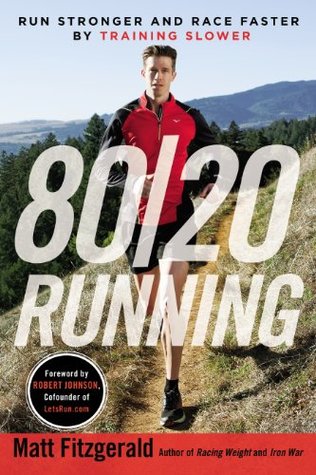More on this book
Community
Kindle Notes & Highlights
Read between
June 19 - October 13, 2024
In well-trained runners, the ventilatory threshold typically falls between 77 percent and 79 percent of maximum heart rate.
Some of the training-induced changes in muscle function that boost performance in, say, a 5K race actually impair performance in something like a 40-yard dash. For example, training to increase aerobic capacity reduces the cross-sectional size of certain muscle fibers. This adaptation leads to economical running over long distances, but it also lessens the maximum power output of the muscles, and as maximum power output goes down, so does top-end speed.
Fast runs may hurt more, but long runs hurt longer.
Mostly-slow training also does a better job of strengthening the parts of the brain where tolerance for suffering resides.
running economy is represented as the amount of oxygen required to sustain a given speed.
All runners become more economical through training, which is to say that they exhibit a trend toward requiring less oxygen to sustain the same speeds.
Research has consistently shown that forced alterations to an individual’s natural running form almost always worsen performance instead of improving it.
Experienced and skilled athletes in all sports exhibit less brain activity, or what I call a quieter brain, than others do when performing sport-specific actions.
The three key characteristics of a self-optimizing system are variation, selection, and repetition.
Simply repeating the stride action, over and over, as much as possible, without interference, is the secret to becoming a more skillful runner.
I suggest you use perceived effort to establish the appropriate intensity at the start of a workout or workout segment. Then rely on pace or heart rate to maintain that intensity while allowing your perceived effort to gradually increase as fatigue sets in.
Start by doing either a thirty-minute time trial, a perceived effort–based test workout, or a talk-test workout to determine your lactate threshold heart rate, then calculate your five heart rate training zones using the percentages in Table 6.1.
Use one of these same workouts to calibrate your perceived effort ratings, anchoring your lactate threshold intensity to a perceived effort of 6 on a 1 to 10 scale.
Determine target pace ranges that correspond to your five heart rate zones either by finding the pace that corresponds with the heart rate marking the low end and high end o...
This highlight has been truncated due to consecutive passage length restrictions.
The human body is not able to absorb increasing training loads for longer than about twenty-four weeks at a stretch.
Each training cycle must be followed by a recuperative period lasting at least a couple of weeks. Despite losing some fitness during such breaks, you will be able to start the next cycle at a higher level of base fitness than you did the last one, and therefore you will also be able to train harder and attain a higher level of peak fitness.
Aim to boost your average weekly running volume by no more than ten miles from year to year.
Hill repetitions offer many of the same benefits as interval runs (namely, increased aerobic capacity and high-intensity fatigue resistance, as well as improved running economy). But hill repetitions are less stressful on the legs because impact forces are much lower on an upward slope. For this reason, hill repetition runs make a good bridge between base training and peak training.
long interval run features repeated efforts of three to five minutes in Zone 4. Long interval runs maximize high-intensity fatigue resistance.


